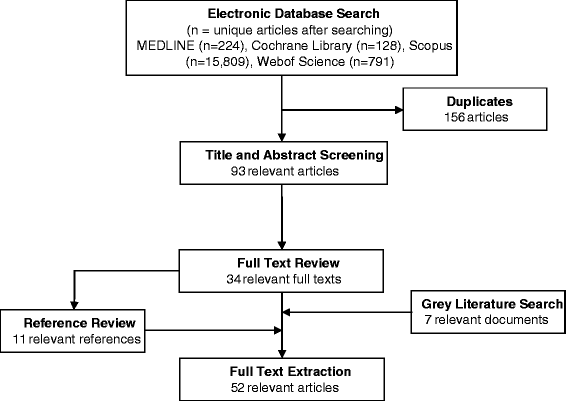A review of methods and tools to assess the implementation of government policies to create healthy food environments for preventing obesity and diet-related non-communicable diseases
- PMID: 26846789
- PMCID: PMC4743239
- DOI: 10.1186/s13012-016-0379-5
A review of methods and tools to assess the implementation of government policies to create healthy food environments for preventing obesity and diet-related non-communicable diseases
Abstract
Background: Policies to create healthy food environments are recognized as critical components of efforts to prevent obesity and diet-related non-communicable diseases. There has not been a systematic review of existing methods and tools used to assess the implementation of these government policies. The purpose of this study was to review methods and tools used for assessing the implementation of government policies to create healthy food environments. The study conducted a systematic literature search. Multiple databases as well as the grey literature were searched. All study designs and review papers on assessing the implementation of government policies to create healthy food environments were included. A quality assessment of the methods and tools identified from relevant studies was carried out using the following four criteria: comprehensiveness, relevance, generalizability and feasibility. This quality assessment was completed by two independent reviewers.
Results: The review identified 52 studies across different policy areas, levels and settings. Self-administered questionnaires and policy checklists were most commonly applied to assess the extent of policy implementation, whereas semi-structured interviews were most commonly used to evaluate the implementation process. Measures varied widely, with the existence of policy implementation the aspect most commonly assessed. The most frequently identified barriers and facilitators for policy implementation were infrastructure support, resources and stakeholder engagement. The assessment of policy implementation on food environments was usually undertaken in combination with other policy areas, particularly nutrition education and physical activity. Three tools/methods were rated 'high' quality and 13 tools/methods received 'medium' quality ratings.
Conclusions: Harmonization of the available high-quality methods and tools is needed to ensure that assessment of government policy implementation can be compared across different countries and settings and over time. This will contribute to efforts to increase government accountability for their actions to improve the healthiness of food environments.
Figures
References
-
- Ledikwe J, Blanck H, Kettel Khan L, Serdula M, Seymour J, Tohill B, et al. Dietary energy density is associated with energy intake and weight status in US adults. Am J Clin Nutr. 2006;83:1362–8. - PubMed
-
- World Health Organization . Global status report on noncommunicable diseases 2010. Geneva: World Health Organization; 2011.
-
- Swinburn B, Vandevijvere S, Kraak V, Sacks G, Snowdon W, Hawkes C, et al. Monitoring and benchmarking government policies and actions to improve the healthiness of food environments: a proposed government healthy food environment policy index. Obes Rev. 2013;14(Suppl 1):24–37. doi: 10.1111/obr.12073. - DOI - PubMed
Publication types
MeSH terms
LinkOut - more resources
Full Text Sources
Other Literature Sources
Medical
Molecular Biology Databases


